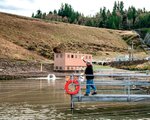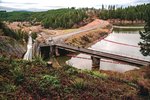

The Office of Chehalis Basin suggests that modifications to the existing fish passage systems on the Skookumchuck Dam could be the most effective alternative for the benefit of fish, should the dam remain standing.
Such action could help preserve endangered Chinook, coho and steelhead.
That’s just one alternative being discussed as the Office of Chehalis Basin takes a look at various options ahead of the planned shutdown of TransAlta’s final coal-fired unit in 2025.
The Office of Chehalis Basin recently completed phase one of a study on possible alternatives for the future of the Skookumchuck Dam, discovering costs for the possible alternatives for the dam — the conversion of the facility to one of flood mitigation or its removal — with a great emphasis put on how those options would affect fish runs.
If the dam were to be modified to become a flood mitigation and storage operation, the modifications would cost upwards of $30 million, while its removal — which would create a free passage for fish — would cost between $20 million and $50 million.
In a webinar, the Office of Chehalis Basin last week detailed the results of phase one of the study, though no estimates on the modification of the dam’s existing fish-passage systems were available at the time.
The Skookumchuck Dam, located 9 miles east of Bucoda and built in 1970, supplies water to the TransAlta coal plant. TransAlta is the owner and operator.
Should the dam remain standing after 2025, TransAlta could continue making its water bank available for local municipalities to draw water from as a form of additional water rights. The bank was made possible by the unused water in the existing water rights the dam has amassed since TransAlta turned off its first coal-fired unit.
An earthfill structure, the dam is 190 feet high and 1,340 feet long, forming the 4-mile long Skookumchuck Reservoir that establishes the outflows that supply water to the coal plant.
Currently, the dam is only partially helpful in controlling flood waters through the use of its reservoir.
“The reservoir only reduces downstream flooding when it’s low,” said Nat Kale, planner with the Office of Chehalis Basin, during the webinar. “In 2007, when the biggest flood in recent history hit the area, the reservoir was nearly empty. So there was plenty of room to hold back water, which reduced flooding in Bucoda. During the storm in January of this year, the reservoir was full, so the water from the storm passed right over the top of it and on to Bucoda and Centralia, where it made the flooding worse.”
The conversion of the dam into a flood-mitigation structure might mean the installation of a new outlet tunnel next to the dam’s spillway to increase the amount of water that can be discharged from the dam to keep the reservoir low enough to function as a flood-retention reservoir. This modification would cost around $20 million, with an estimated $10 million more for a possible gate over the spillway to increase the reservoir’s water level even further. The $30 million would not include increased costs of operation or maintenance.
Merri Martz, consultant with on the project for the Office of Chehalis Basin, said during the webinar that the flood mitigation option would be ineffective for the downstream passage of juvenile salmon, since the reservoir has to be high enough for the fish to either swim over the spillway, or through a fish-passage tunnel about 12 feet below the spillway, called a sluice.
“Fish passage is compatible with the water supply purpose (of the dam), and that makes sense,” Martz said. “The dam was designed for water supply, and the fish passage (systems) were designed to be compatible with water supply.”
A trap-and-haul system is currently being used to get adult steelhead upstream, but the spillway and sluice are the only viable ways for the juvenile fish to get downstream.
And the sluice, without modification, is currently too steep for the juvenile salmon to safely navigate due to the dam’s discharged water’s velocity and turbulence.
“Modifications to the fish sluice … to provide a different passageway for fish would be a lot more effective than what is currently out there,” Martz said.
And the complete or partial removal of the dam would increase the ability of the salmon to swim freely downstream, but it would be the most costly alternative at up to $50 million, which would not include habitat restoration efforts.
The phase one study can be found at https://app.box.com/s/2ikcs1q1bcvaajp12zd1wswme75ka2vb, and more information can be accessed at https://ecology.wa.gov/Blog/Posts/March-2022/Ecology-assessing-potential-Skookumchuck-Dam-impro.
Those interested can email Kale at nkal461@ecy.wa.gov with questions.
Phase two of the study should be complete by 2023 to fully investigate the pros and cons of the dam’s alternatives.
“Kind of the takeaway from the phase one analysis … was that fish passage and flood storage are not currently compatible,” Martz said. “The reason for that, is to provide a long period of time for juvenile fish to exit the dam, you have to keep the reservoir fairly full … so the water can spill out of the fish sluice. And the flood storage option, you would want to reduce the level of the reservoir as low as you could and maintain it through much of the winter and spring throughout the flood season.”